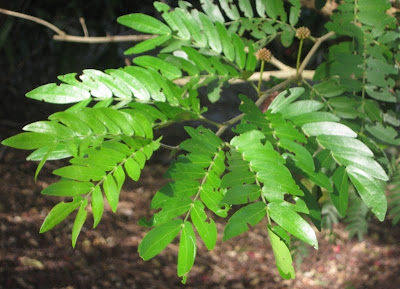Wednesday, March 5, 2014
Calliandra
A large genus of close to 200 species of trees and shrubs native to tropical America with a few in southern India and Madagascar.
Most species prefer full sun on well drained soil. Most species are drought tolerant and in fact come from regions with a distinct dry season. They can be clipped and many species can be used for hedging though are also attractive in natural form.
Propagation is from seed soaked for 24 hours in hot water before sowing during spring.
Propagation can also be from cuttings taken during winter.
Calliandra californica
A fast growing, open shrub native to the Baja Peninsula of Mexico.
Moderate growing. Some records include: 3 years - 4 feet; largest on record - 12 x 12 feet.
Reaches up to 4 feet as a perennial where cold.
The small pinnate leaves are composed of oval leaflets. The foliage is mid-green.
The scarlet-red powderpuff flowerheads, up to 1.5 inches across, are borne during most of the year.
The scarlet-red puffball flower clusters are up to 1 inch across.
The branches are wiry.
Hardy zones 9 to 11 ( tolerating 22 F as a shrub but will resprout rapidly from base to as low as 15 F ) in full sun to partial shade. Thrives in the arid landscape.
Calliandra calothyrsis
A very fast growing, straight trunked, small tree native to Central America.
Some records include: 6 months - 12 feet; largest on record - 40 x 20 feet with a trunk diameter of 1 foot. It has been planted to improve soil and stabilize slopes in Indonesia. It will resprout vigorously if cut to ground.
The feathery leaves are up to 12 inches in length.
The red flowers consist of stamens up to 2 inches in length.
The bark is white.
Hardy zones 10 to 12 requiring 40+ inches of rainfall per year. It does not tolerate waterlogged soil and will die if waterlogged for 2 weeks.
Calliandra conferta
A small shrub, reaching a maximum height of 3 feet, that is native from the southern U.S. to northern Mexico.
The feathery leaves are small and gray-green.
The globular flowerheads are small and white.
The prickly branches are crooked.
Calliandra emarginata
A semi-scrambling large shrub or small tree, native to southern Mexico and central America. Some records include: largest on record - 15 x 20 feet.
It looks similar to C. haematocephala.
The leaves are composed of large, obovate leaflets, up to 2.5 inches in length.
The showy, large, powderpuff flowerheads are scarlet-red.
Hardy zones 10 to 12 ( tolerating 30 F ).
Calliandra eriophylla ( Fairy Duster )
An attractive, fast growing, stiff, dense, spreading, evergreen, small shrub, reaching a maximum size of 4 x 8 ( rarely over 6 feet across ) feet, that is native from California to western Texas; south into northern Mexico.
It looks great in the arid climate landscape and can form a 5 gallon size plant in a single year.
The feathery, bipinnate leaves, up to 5 inches in length, are composed of pinnae which include 12 to 20 tiny, narrow, elliptic leaflets. The foliage is bright green.
The abundant, white ( with pink tips ) puffball flower clusters are borne late spring into autumn.
Hardy zones 7 to 11 ( may resprout from base in zone 6 ). Very drought tolerant.
Calliandra haematocephala ( Powderpuff Tree )
A scrambling to spreading large shrub or it trained a small tree, native to northern South America. Some records include: 1st year - 6 x 3 feet; 10 years - 17 x 17 feet; largest on record - 30 x 25 ( rarely over 17 x 17 ) feet with a trunk diameter of 2 feet.
The bipinnate leaves, up to 18 x 16 inches, are composed of pinnae consisting of 16 to 24, narrow-oval leaflets, up to 3.2 inches in length. The foliage is very glossy, luxuriant mid-green.
The spectacular flowers are scarlet-red ( less often pink or white ) are borne on terminal, globular heads, up to 3 inches across. The flowers are borne nearly all year long in the tropics, during fall and winter in cooler regions.
Hardy zones 9 to 12 ( tolerating as low as 20 F ) in full sun to partial shade. Prefers a site protected from excessive wind. Prefers acidic to alkaline soil, it is very tolerant of drought and clay but does not tolerate salt.
Thrives in humid subtropical to tropical climates.
It is often cut back by up to 2/3 after flowering to induce vigor.
* photos taken on Jan 3 2011 @ Deerfield Beach Arboretum, Florida





Calliandra portoricensis ( White Powderpuff )
An evergreen small tree native to the Caribbean and Central America. Some records include: fastest recorded growth rate - 4 feet; largest on record - 27 x 20 feet.
The finely divided leaves are composed of pinnae up to 3 inches in length, which themselves are composed of leaflets up to 0.7 inches in length.
The pinnae fold up at night.
The drooping, globular white flower clusters are up to 1.5 inches across.
The flowers are borne profusely during most of the year.
Hardy zones 10 to 12 in full sun to partial shade, thriving in the subtropics and tropics.
* photo taken on Jan 3 2011 @ Deerfield Beach Arboretum, Florida

Calliandra surinamensis ( Pink and White Powderpuff )
A gracefully arching, vase-shaped, small tree, reaching a maximum size of 25 x 40 feet, that is native to northern South America. Fast growing, it can increase at up to 4 feet or more in a year.
The pinnate leaves, up to 3.2 inches in length, are composed of leaflets, up to 1.3 inches in length.
The flowerheads, up to 1.5 inches across, are white, deepening to pale purplish-pink at the tips.
Hardy zones 10 to 12 ( perennial in zone 9 ). Very drought and salt tolerant.
Calliandra tweedii ( Brazilian Flame Bush )
A rapid growing, long-lived, dense, multi-thick-stemmed, evergreen shrub, reaching a maximum size of 20 x 15 ( rarely over 10 x 10 ) feet, that is native to southern Brazil and Uruguay.
The ferny pinnate leaves, up to 6 inches in length, are composed of tiny leaflets that fold up at night. The foliage is luxuriant mid-green.
The fluffy, pompom-like flowerheads, up to 3 inches across, are intense deep red.
The flowers are borne spring to fall.
Hardy zones 8 to 11, thriving in moist, sandy soil. Drought and clay tolerant.
Older plants can be cut back to ground to regenerate, in fact this is often done regularly every few years. It can also be used as a hedge if clipped regularly.
Labels:
calliandra
Subscribe to:
Post Comments (Atom)

No comments:
Post a Comment